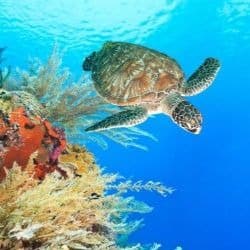Research In To Baffling Deaths Of Australian Sea Turtles

The latest research surrounding environmental stressors caused by human activity and how it is harming coastal green sea turtle populations has been released. It is hoped the research will inform future conservation efforts. The study sought to evaluate the health of turtles, the quality of water and any other factors that may have caused the catastrophic mass death of Australian green turtles. The researchers say they found evidence of heavy metals with cobalt in particular present in sea turtle populations.
Now way to determine the exact cause
It is impossible to say for sure what the exact cause for the event was because there was major flooding and cyclones in that part of Australia a couple of years before the study and that could be the reason why sediment rich in heavy metals were drawn out, that had probably been lying in rivers and streams for more than half a century. Green turtles are an endangered species and are named not for their shells, but for the greenish colour of their fat.
Human activity must have had some impact
Green turtles are found mainly in subtropical and tropical waters according to WWF. The organisation provided a lot of the funding for the study. Large populations of green turtles live, feed and nest on Australia’s great barrier reef. The Rivers to Reef to Turtles project took place between 2014 and 2017 and examined green turtle populations at bays in Northern Queensland, Cleveland and Upstart that are recognised as being affected by human activity plus a more remote pristine area known as the Howick Group of islands.
Large number of turtles died
The study was in response to a very large number of turtles dying between 2012 and 2013 which many conservationists claimed was the result of a wide variety of reasons ranging from agricultural and industrial toxins to climate change. The team looked at turtle blood over a period of time searching for signs of contamination and sickness. Turtle barnacles were also counted because a high barnacle count is consistent with poor health.
Turtles at the control site healthy
When dead turtles were found an in-depth necropsy was conducted and there were elevated levels of enzymes that cause muscle injury and or illness in the turtles. The turtles of Upstart Bay were found to have elevated white cell counts which suggest they were fighting infection. 20 per cent of Cleveland Bay juvenile turtles had high barnacle levels whilst 10 per cent of young turtles in Upstart Bay displayed the same symptoms. Barnacle growth was not observed in turtles at the pristine control site.
Normalcy returning at some sites
Towards the end of the study, the researched discovered evidence suggesting Cleveland Bay’s green turtle population was returning to normal though the population in Upstart Bay continues to face problems. It is suspected that the reasons behind the deaths is that the turtles live in areas where urbanisation, industry and farming have contaminated the ecosystem, in particular, there was evidence of heavy metals, in particular cobalt in the turtle blood.
Green turtles vital to the ecosystem
Green turtles migrate vast distances between the beaches where they hatch their feeding grounds. The species also faces the threat of their eggs being over-harvested, adults being hunted or caught up in fishing nets as well as the loss of beach sites where they nest WWF says. The green turtle is the only herbivore sea turtle and this makes it ecologically important. When they feed, the vegetation continues to remain productive in the same way a lawn remains healthy after being mowed. The species also recycles digested nutrients.



